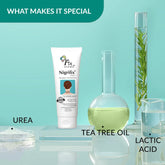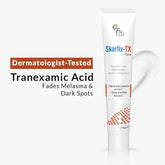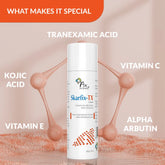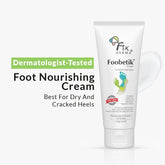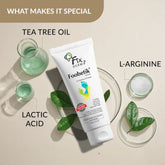Monsoon Sunscreen Guide: How To Choose SPF For Humid, Cloudy Days

Table of Content
As the monsoon season brings relief from the scorching summer heat, it also brings with it a hatful of skincare concerns. Amidst cloudy skies and constant humidity, sunscreen is something that often gets pushed aside. It is mostly mistaken as a summer product that has nothing to do when the sun is not showing up in the sky. The truth is, sun protection is essential year-round even on cloudy, rainy days. UV rays still penetrate through clouds and glass, silently damaging your skin and worsening pigmentation and breakouts.
So, how do you pick the best sunscreen for the monsoon? In this guide, we’ll cover how the monsoon impacts your skin, what SPF works best for the monsoon season, and the types of sunscreen to use.

How Monsoon Affects Your Skin Health
In the monsoon, skin is a breeding ground for a variety of problems like oiliness, clogged pores, fungal infections, and unexpected tanning. The damp, sticky atmosphere boosts sebum production while UV rays continue to pass through the clouds. UVA rays (which lead to aging) are present all the time, and UVB rays (which cause sunburn) can reach you even through windows or light rain.
Here’s why dermatologists put a stress on how not applying sunscreen in monsoon season can lead to:
- Sudden tanning and pigmentation
- Worsening of melasma or sunspots
- Long-term photoaging
- Acne flare ups and inflammation

What Happens If You Don’t Apply Sunscreen In Monsoon
One of the biggest skincare errors is the myth that cloudy weather doesn’t need SPF. Although it may be overcast outside, 80% of UV rays still pass through the clouds. What this means is that your skin will still continue to absorb radiation that does both immediate and long-term damage.
If you miss sunscreen this season, you risk:
- Deepening of acne scars and post-inflammatory hyperpigmentation
- Faster breakdown of collagen and elastin
- Uneven skin tone and texture
- Enhanced sensitivity due to moist air and pollutants

What SPF Works Best on Cloudy Days
SPF (Sun Protection Factor) does not lose relevance in cloudy weather, it becomes even more important. Your appropriate SPF varies with the amount of time you spend outdoors and indoors:
- SPF 30 is sufficient for most indoor or low-exposure days. As UV light, laptop screens can damage your skin.
- SPF 50 in sunscreen is best for days when you are stepping out in the sun, even if its cloudy.
For the monsoon season in India, SPF 50+ PA+++ is generally advised by dermatologists. Choose sunscreens that block both UVA and UVB rays and provide broad spectrum protection to your skin. This prevents tanning, dark spots, and aging, regardless of the season.

How to Choose the Right Sunscreen for Monsoon
Monsoon skincare needs are special. You don’t need one that clogs pores or gets greasy during the humidity. Rather, look for formulas that are made for humid, oily, and acne-prone skin.
Here’s a list to look for in a best sunscreen:
- Gel-based sunscreen: They are lightweight and non-comedogenic.
- Water and sweat-resistant: Provides longer protection from sudden drizzles.
- Fragrance-free & non-comedogenic: To prevent irritation or breakouts.
- Contains antioxidants like niacinamide or vitamin E for added skin defense.

Best Sunscreens for Rainy Days: Look for products that combine science and skin comfort. Some sunscreen recommended by 15000+ dermatologists includes:
Fixderma Shadow SPF 50+ Gel Sunscreen: Lightweight, non-sticky gel sunscreen that offers broad-spectrum protection without clogging pores, ideal for oily and humid-weather skin.
Fixderma Shadow SPF 30+ Gel Sunscreen: An everyday, oil-free gel sunscreen with SPF 30+ that protects without leaving any greasy residue.
Fixderma Shadow Pore Minimizing Gel Sunscreen SPF 50+: Expertly formulated gel sunscreen with pore-minimizing ingredients and SPF 50+ to control excess oil while protecting your skin from harmful UV rays.
Non-Greasy Sunscreen for Humid and Oily Skin
Humidity is the nemesis of a calm, clear and smooth face in monsoon. Most people don’t apply sunscreen because it “feels too heavy” during the monsoon. The trick is to change to a gel or serum-based SPF that gets easily absorbed into your skin.
Look for these key ingredients:
- Zinc Oxide - A potent UV filter that reflects the damage-causing UVA & UVB rays from your skin.
- Titanium Dioxide - It shields the skin from UVA & UVB rays and is rated no risk to skin sensitivity.
- Niacinamide - It calms inflammation and regulates oil production
- Vitamin E - It possesses anti-inflammatory properties that help in calming red, irritated skin.
Best Sunscreens for Oily Skin In Monsoon
Fixderma Shadow SPF 50+ A-Gel Sunscreen: Advanced gel formula enriched with antioxidants, perfect for acne-prone and sensitive skin in humid, rainy conditions.
Fixderma Shadow SPF 30+ A-Gel Sunscreen: Soothing SPF 30+ gel infused with antioxidant benefits, suited for daily monsoon protection and oily skin types.

How To Use Sunscreen In Monsoon
Your monsoon skincare regime during the monsoon should be minimal but regular.
Here’s how to apply sunscreen correctly:
- Wash with a gentle, pH-balanced face cleanser.
- Apply a lightweight, oil-free moisturizer.
- Use a gel-based sunscreen for your face and neck, 15-20 minutes before going out.
- Let it absorb completely before applying makeup or stepping out.
Apply it even if you're indoors but exposed to indirect light, windows, or screens (blue light can also damage your skin).

How to Reapply Sunscreen During Monsoon
Rain is likely to wash away sunscreen quicker than sweat. That’s why reapplication becomes very important, especially if you're outdoors or get wet.
- Reapply every 2-3 hours if you're outside.
- If you’re indoors with light exposure, every 4-5 hours is okay.
- Use SPF sprays for on-the-go touch-ups over makeup.
Bonus tip: Carry a travel-size sunscreen in your bag during the monsoon season; it’s as essential as an umbrella in your bag.
Final Thoughts
Monsoon might not be sunny and bright, but UV damage does not take a break. The high humidity in combination with cloudy weather creates a false belief that you do not need SPF anymore. But the reality is, daily use of sunscreen is your best line of defense against premature aging, skin irritation and pigmentation.
With dermatologist-tested formulas, particularly non-greasy, water-resistant sunscreens, you can have fun in the rain without risking your skin. Don’t skip it. Just replace it with whatever your skin prefers better during monsoon.
Your skin is not bothered by the weather. It only cares about how you take care of it.
Frequently Asked Questions
-
Do I need sunscreen during monsoon or cloudy days?
Yes, UV rays can penetrate clouds and still damage your skin during the monsoon, making daily sunscreen an essential for protection against tanning, pigmentation, and long-term sun damage.
-
What is the best sunscreen for humid weather and oily skin?
Fixderma Shadow SPF 50+ Gel Sunscreen is the best sunscreen for oily skin during humid weather. It is a lightweight, gel-based and non-comedogenic formula that won’t clog pores or feel greasy in high humidity.
-
Which type of sunscreen is ideal for the monsoon?
Gel-based sunscreens are ideal for monsoon because they are lightweight, absorb quickly, and suit humid conditions. Cream-based sunscreens can feel heavy or sticky during rainy or windy weather.
-
Can I skip sunscreen if I stay indoors on rainy days?
No, sunscreen is still important indoors during rainy days, especially if you're near windows or screens. UVA rays can pass through glass and contribute to premature aging and pigmentation.
-
Is SPF 30 enough for monsoon, or should I go for SPF 50?
SPF 30 is good for light sun exposure, but SPF 50 sunscreen is recommended during monsoon due to unpredictable UV levels. It offers better protection in case the sun breaks through suddenly or if you’re spending time outdoors between showers.
-
How often should I reapply sunscreen in humid or rainy weather?
In monsoon weather, reapply sunscreen every 2–3 hours, especially if your skin gets wet from rain or sweating. Even water-resistant sunscreens can wear off due to moisture and humidity, so frequent reapplication ensures consistent protection.

